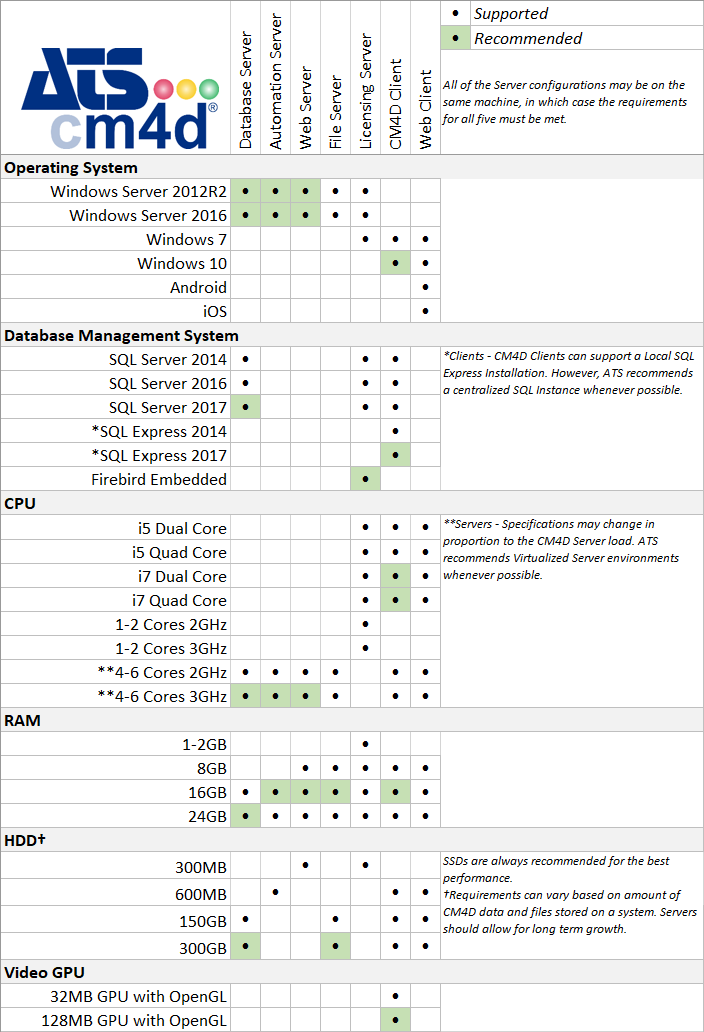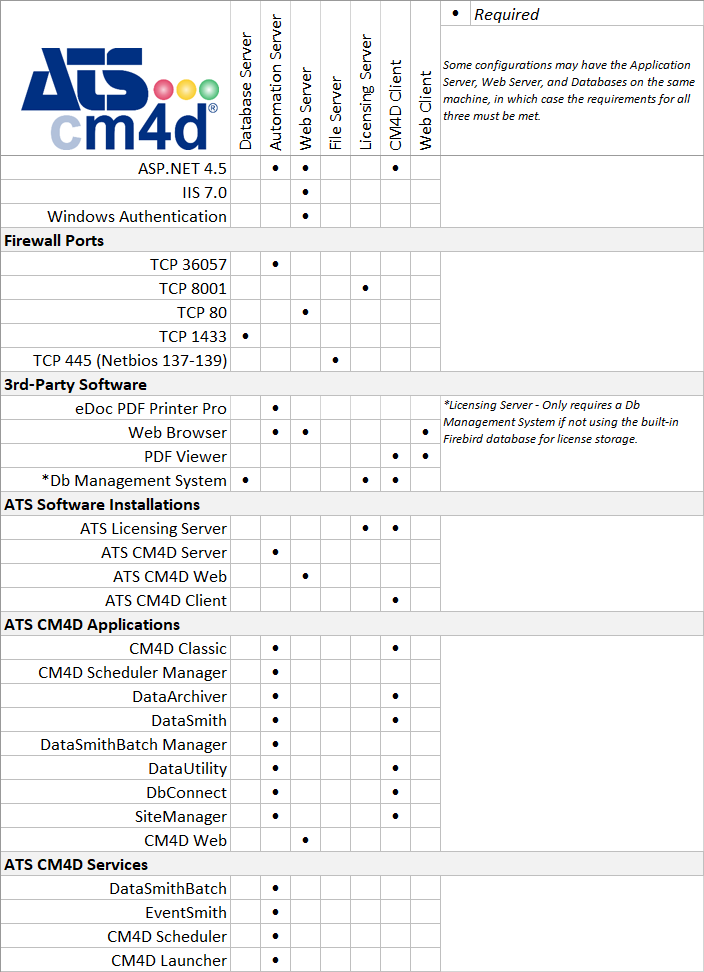
This document lists the hardware and software requirements and recommendations for the basic configurations of CM4D v23.4 or higher. These specifications outlined here are intended to be a generic guide to use as a starting point in the planning of your ATS CM4D implementation.
Normal Windows System Updates should be installed to ensure the computer has any critical Root Certificate updates that might be required by digitally signed software.
The following software and hardware requirements must be met for the Server that will be running a CM4D Server installation. Some configurations may combine one or more Server types on the same machine, in which case the specifications for all Server role requirements must be met.
Typical use: Large networks with one or more servers hosting centralized databases and running the Site Automation services for multiple CM4D Clients.
The CM4D Automation Server package arrives pre-configured with a single DataSmith Batch process and two CM4D worker processes for CM4D Scheduler. In addition, the CM4D Web application requires its own dedicated CM4D worker processes. The number of CM4D Web worker processes should be based on the number of users who are simultaneously generating reports on demand.
Utilizing current Virtualization technology, you could monitor peak memory demand over a time period to better tune available memory to prevent page swapping. Most Virtualization technology also makes used of shared or balloon memory, which allows the host to dynamically adjust available memory based on load demand.
For information from Microsoft on Memory Limits for Windows Releases, visit: http://msdn.microsoft.com/en-us/library/windows/desktop/aa366778(v=vs.85).aspx
All installations of ATS CM4D rely on an external database to store the quality data. The database can be local to the installation or on a centralized server within a network.
Operating System
· Windows Server 2012R2
· Windows Server 2016
CPU
Specifications may change in proportion to the CM4D Server load. ATS recommends Virtualized Server environments whenever possible.
· 4-6 Cores 2GHz
· 4-6 Cores 3GHz
RAM
· 12GB-16GB or higher (at least 24GB is recommended)
HDD
Disk sizing requirements can vary based on amount of CM4D data and files stored on a system. Servers should allow for long term growth. Your actual sizing will be based on the volume of measurement data you plan to store and analyze with CM4D.
· 150GB or more
SSDs are recommended to increase performance.
Database Management System
· SQL Server 2014
· SQL Server 2016
· SQL Server 2017
Firewall Ports
· TCP 1433-1434 – SQL Server Databases (see here for more details)
If the Server will be used to run the Automation Services used throughout the network, the following requirements must be met.
Operating System
· Windows Server 2012R2
· Windows Server 2016
CPU
Specifications may change in proportion to the CM4D Server load. ATS recommends Virtualized Server environments whenever possible.
· 4-6 Cores 2GHz
· 4-6 Cores 3GHz
RAM
· 12GB-16GB or higher (at least 16GB is recommended)
HDD
· 600MB (software installation footprint)
Network
· 1GB Network speed
Firewall Ports
· TCP 36057 - CM4D Scheduler (see here for more details)
Third Party Software
· eDocPrinter PDF Pro 6.98.6405 or higher Iteksoft
· Internet Explorer 11 or Google Chrome
If the server will be used to host CM4D Web, the following requirements must be met.
Operating System
· Windows Server 2012R2
· Windows Server 2016
CPU
Specifications may change in proportion to the CM4D Server load. ATS recommends Virtualized Server environments whenever possible.
· 4-6 Cores 2GHz
· 4-6 Cores 3GHz
RAM
· 8GB or higher (at least 16GB is recommended)
HDD
· 200MB (software installation footprint)
Network
· 1GB Network speed
Windows Features
· Internet Information Services (IIS) 8.5 or higher
· ASP.NET 4.5
· Windows Authentication
Firewall Ports
· TCP 80 (http:80) - CM4D Web (see here for more details)
The ATS CM4D applications require a shared location to store and access related files such as:
· CM4D Report Templates - *.4dc
· DataSmith translators - *.4DataSmith
· CAD Images - *.wrl, *.jpg, etc.
· RAW Incoming Data Inboxes
· Rendered Reports - *.PDF
These files are used or produced by CM4D Server, CM4DWeb, and any CM4D Clients. For example, if an End User running a CM4D Client does not have access to the file share storing the *.4DC files, they will not be able to view or edit the report templates.
If that CM4D report template includes any part models, the user will also need to have at least read access to the folder where the image file is stored.
Since CM4D is Windows based, this location is represented as a normal Microsoft Windows SMB File Share. For most CM4D Customers, the SMB share used for CM4D files usually resides directly on the CM4D Automation server or on another preexisting SMB file server (such as existing file shares used by used by Quality Department).
Operating System
· Windows Server 2012R2
· Windows Server 2016
CPU
Specifications may change in proportion to the CM4D Server load. ATS recommends Virtualized Server environments whenever possible.
· 2-4 Cores 2GHz
· 2-4 Cores 3GHz
RAM
· 8GB or higher (at least 16GB is recommended)
HDD
Disk sizing requirements can vary based on amount of CM4D data and files stored on a system. Your actual sizing will be based on the volume of measurement data you plan to store and analyze with CM4D.
· 150GB or more
SSDs are recommended to increase performance.
Network
· 1GB Network speed
Firewall Ports
· TCP 445 (Netbios 137-139) – Windows File Share for CM4D document and translators (see here for more details)
The following software and hardware requirements must be met for the machine that will be running as a Client system.
This section includes the requirements for CM4D Clients that will have the CM4D installation, ATS Licensing, and database on the same machine.
Although 64-bit is recommended for best performance, CM4D Client installations are still available as an x86 install for 32-bit OS.
Typical use: This configuration is usually the Node-locked CM4D Classic Developer and DataSmith licenses, and is used by report template developers and DataSmith translator developers.
Other use: CM4D Interactive or CM4D Workcell systems.
Operating System
· Windows 7
· Windows 10
CPU
· i5 Dual or Quad Core
· i7 Dual or Quad Core
RAM
· 8GB or higher (at least 16GB is recommended)
HDD
Disk sizing requirements can vary based on amount of CM4D data and files stored on a system. Your actual sizing will be based on the volume of measurement data you plan to store and analyze with CM4D.
· 400MB (software installation footprint)
· 150GB or more if storing the database, data files, documents, and licensing
SSDs are recommended to increase performance.
Video GPU
A discrete GPU is preferred.
· 32MB GPU with OpenGL
· 128MB GPU with OpenGL
CM4D and DataSmith dialogs require a minimum screen resolution of 1280x1024. For wide screens, a minimum resolution of 1920x1080 is recommended.
Database Management System
CM4D Clients can support a local SQL installation. However, ATS recommends a centralized SQL Instance whenever possible.
· SQL Server Database
§ SQL Server 2014
§ SQL Server 2016
§ SQL Server 2017
§ SQL Express 2014
§ SQL Express 2017
ATS Software
· ATS Licensing 3.0
This section includes the requirements for Web clients using the CM4D Web interface via a web browser. This configuration does not require a CM4D or CM4D Web install.
Typical use: Multiple users throughout the network, those with limited knowledge of CM4D, but need on-demand access to reports.
Operating System
· Windows
· iOS
· Mobile Devices with a compatible web browser and PDF viewer
Third Part Software
· PDF Viewer - Chrome and Edge have built-in pdf viewers
· Web Browser - all major browsers are compatible with CM4D Web (Chrome, Firefox, Internet Explorer, Microsoft Edge, Opera and Safari)
ATS CM4D v23.4 requires ATS Licensing Server 3.0. This application can be installed on any system, but it is typically installed on the same machine as the Database server.
Operating System
· Windows Server 2012R2
· Windows Server 2016
CPU
· 1-2 Cores 2GHz
· 1-2 Cores 3GHz
RAM
· 2GB or higher
HDD
· 300MB (software installation footprint)
Database Management System
This is only required if you are not using the built-in Firebird database for license storage.
· SQL Server 2014
· SQL Server 2016
· SQL Server 2017
Firewall Ports
· TCP 8001 - ATS Licensing (see here for more details)
This is an overview with definitions of ports that are used by ATS CM4D by default.
This port is used by CM4D to communicate between the ATS Licensing Server and clients. When the client PC runs a CM4D application, it sends a request to the application server (where the ATS Licensing Server is installed) to check if there is an available license in the database via ATS Licensing Manager on TCP port 8001. If any available license exists, the application server sends the information back to the client to run related application.
If TCP 8001 is not open, clients will not able to run any CM4D application in their local environment.
This port is used by CM4D to open CM4DWeb on the client PC via the Internet browser (i.e. Internet Explorer). In CM4DWeb, clients are able to see all published and managed reports and print a PDFs to save to their local environment. A client can subscribe to any reports to get an alarm email according to related reports event configurations.
If TCP 80 (http:80) is not open, clients will not able to open CM4DWeb to print PDFs and to get alarm emails (EventSmith).
This port is used by CM4D to reach the Scheduler Manager Services (which is running on the application server) on client PCs. Clients who that have privileges on Scheduler Manager can control scheduled reports and alarms to print PDFs or trigger alarm conditions on report templates. In addition, there are two services on the application server (ATS CM4D Scheduler and ATS CM4D Launcher) that are running for scheduled report processing.
If TCP 36057 is not open, a client will not able to reach the Scheduler Manager to configure or manage unless Scheduler Manager is located on the local server.
This port is a default port for Microsoft SQL Server database management system (MSSQL) server. As CM4D uses MS SQL Server to locate CM4D Site and CM4D data source Databases, this port should be open.
If you are using a Named Instance, you must also open a UDP port 1433-1434.
This port is a default port for Windows for File Sharing. In computer networking, Server Message Block (SMB), one version of which was also known as Common Internet File System (CIFS), operates as an application-layer network protocol mainly used for providing shared access to files, printers, and serial ports and miscellaneous communications between nodes on a network. CM4D needs a shared folder on the network to store all CM4D managed report templates, translators, Inboxes, etc. Clients should be able to reach this shared folder to modify and manage report templates and translators. DataSmith Batch Manager is using this shared folder to locate defined Inbox folders and to process automatically data files via DataSmith.
If TCP 445 is not open, clients cannot work on any CM4D Files or update any DataSmithBatch Settings.

